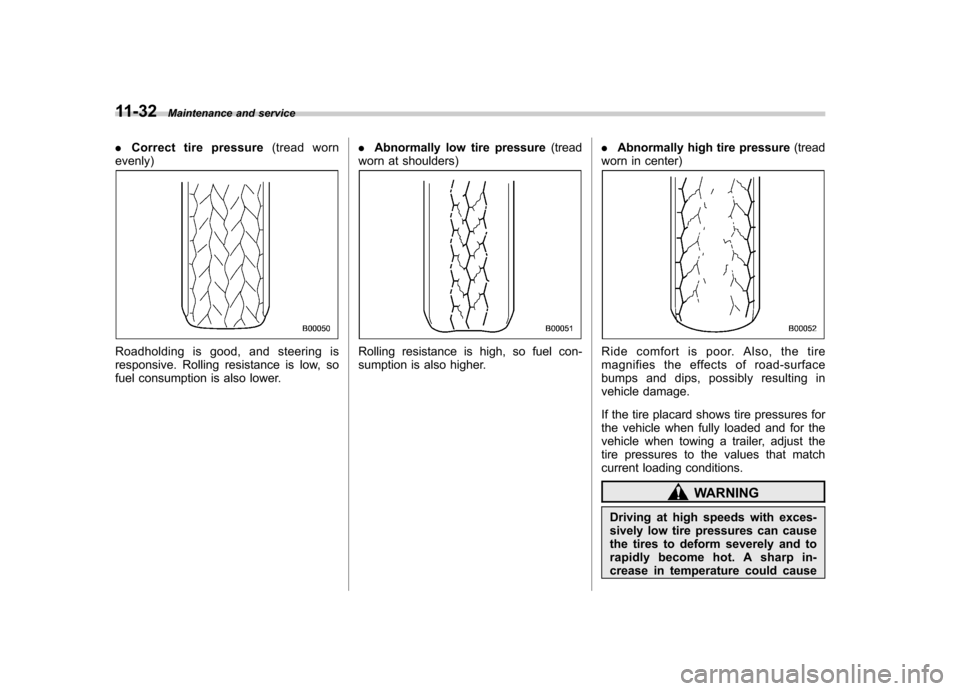2007 SUBARU IMPREZA WRX towing
[x] Cancel search: towingPage 288 of 364

11-12Maintenance and service
&Recommended grade and
viscosity under severe driv-
ing conditions
If the vehicle is used in desert areas, in
areas with very high temperatures, or
used for heavy-duty applications such as
towing a trailer, use of oil with the following
grade and viscosities is recommended.
API classification SM (or SL): SAE viscosity No.: 30, 40, 10W-50,
20W-40, 20W-50
& Synthetic oil
You can use synthetic engine oil that
meets the same requirements given for
conventional engine oil. When using
synthetic oil, you must use oil of the same
classification, viscosity and grade shown
in this Owner ’s Manual, and must follow
the oil and filter changing intervals shown
in the maintenance schedule. Cooling system
WARNING
Never attempt to remove the radia-
tor cap until the engine has been
shut off and has cooled down
completely. Since the coolant is
under pressure, you may suffer
serious burns from a spray of boil-
ing hot coolant when the cap isremoved.
CAUTION
. The cooling system has been
filled at the factory with a high
quality, corrosi on-inhibiting,
year-around coolant which pro-
vides protection against freezing
down to �33 8F( �36 8C). For add-
ing, use genuine SUBARU cool-
ant or an equivalent: a mixture of
50% soft water (or clear and
drinkable water) and 50% phos-
phate or non-amine type coolant.
Use of improper coolants may
result in corrosion in the cooling
system. It is important to main-
tain protection against freezing
and corrosion, even if freezing temperatures are not expected.
Never mix different kinds of cool-ant.
. Do not splash the engine coolant
over painted parts. The alcohol
contained in the engine coolant
may damage the paint surface.
& Cooling fan, hose and con- nections
Your vehicle employs an electric cooling
fan which is thermostatically controlled to
operate when the engine coolant reaches
a specific temperature.
If the radiator cooling fan does not operate
even when the engine coolant tempera-
ture gauge exceeds the normal operating
range, the cooling fan circuit may be
defective. Check the fuse and replace it
if necessary. If the fuse is not blown, have
the cooling system checked by your
SUBARU dealer.
If frequent addition of coolant is neces-
sary, there may be a leak in the engine
cooling system. It is recommended that
the cooling system and connections be
checked for leaks, damage, or looseness.
Page 308 of 364

11-32Maintenance and service
.Correct tire pressure (tread worn
evenly)
Roadholding is good, and steering is
responsive. Rolling resistance is low, so
fuel consumption is also lower. .
Abnormally low tire pressure (tread
worn at shoulders)Rolling resistance is high, so fuel con-
sumption is also higher. .
Abnormally high tire pressure (tread
worn in center)Ride comfort is poor. Also, the tire
magnifies the effects of road-surface
bumps and dips, possibly resulting in
vehicle damage.
If the tire placard shows tire pressures for
the vehicle when fully loaded and for the
vehicle when towing a trailer, adjust the
tire pressures to the values that match
current loading conditions.
WARNING
Driving at high speeds with exces-
sively low tire pressures can cause
the tires to deform severely and to
rapidly become hot. A sharp in-
crease in temperature could cause
Page 348 of 364

13-8Consumer information and Reporting safety defects
cation and a tightening sequence
specification for the wheel nuts can
be found “Flat tires ”section in chapter
9. & Vehicle load limit –how to
determine
The load capacity of your vehicle is
determined by weight, not by avail-
able cargo space. The load limit of
your vehicle is shown on the vehicle
placard attached to the driver ’s side
B-pillar. Locate the statement “The
combined weight of occupants and
cargo should never exceed XXX kg or
XXX lbs ”on your vehicle ’s placard.
The vehicle placard also shows seat-
ing capacity of your vehicle.
The total load capacity includes the
total weight of driver and all passen-
gers and their belongings, any cargo,
any optional equipment such as a
trailer hitch, roof rack or bike carrier,
etc., and the tongue load of a trailer.
Therefore cargo capacity can be
calculated by the following method.
Cargo capacity = Load limit �(total
weight of occupants + total weight of optional equipment + tongue load of a
trailer (if applicable))
For towing capacity information and
weight limits, refer to
“Trailer towing ”
section in chapter 8. ! Calculating total and load ca-
pacities varying seating con-
figurations
Calculate the available load capacity
as shown in the following examples:
Example 1A
Vehicle capacity weight of the vehicle
is 900 lbs (408 kg), which is indicated
on the vehicle placard with the state-ment “The combined weight of occu-
pants and cargo should never exceed 900 lbs or 408 kg
”.
For example, if the vehicle has one
occupant weighing 154 lbs (70 kg)
plus cargo weighing 662 lbs (300 kg).
1. Calculate the total weight.
2. Calculate the available load capa-
city by subtracting the total weight
from the vehicle capacity weight of
900 lbs (408 kg).
3. The result of step 2 shows that a
further 84 lbs (38 kg) of cargo can be
carried.
Page 351 of 364

the body.
Therefore, this means that the vehicle
cannot necessarily be loaded up to
the tire’s maximum load rating on the
tire sidewall. & Adverse safety conse-
quences of overloading on
handling and stopping and
on tires
Overloading could affect vehicle
handling, stopping distance, vehicle
and tire as shown in the following.
This could lead to an accident and
possibly result in severe personal
injury. . Vehicle stability will deteriorate.
. Heavy and/or high-mounted loads
could increase the risk of rollover. . Stopping distance will increase.
. Brakes could overheat and fail.
. Suspension, bearings, axles and
other body parts could break or
experience accelerated wear that will
shorten vehicle life. . Tires could fail.
. Tread separation could occur.
. Tire could separate from its rim. &
Steps for Determining Cor-
rect Load Limit
1. Locate the statement “The com-
bined weight of occupants and cargo
should never exceed XXX pounds ”on
your vehicle ’s placard.
2. Determine the combined weight of
the driver and passengers that will be
riding in your vehicle.
3. Subtract the combined weight of
the driver and passengers from XXX
kilograms or XXX pounds.
4. The resulting figure equals the
available amount of cargo and lug-
gage load capacity. For example, ifthe “XXX ”amount equals 1,400 lbs
(635 kg) and there will be five- 150 lbs
(68 kg) passengers in your vehicle,
the amount of available cargo and
luggage load capacity is 650 lbs. (1,400 �750 (5 6150) = 650 lbs)
5. Determine the combined weight of
luggage and cargo being loaded on
the vehicle. That weight may not
safely exceed the available cargo
and luggage load capacity calculated
in Step 4.
6. If your vehicle will be towing a trailer, load from your trailer will be
transferred to your vehicle. Consult
this manual to determine how this
reduces the available cargo and
luggage load capacity of your vehicle.
Consumer information and Reporting safety defects
13-11
Page 361 of 364

14-8Index
Specifications ............................................................ 12-2
Speedometer ....................................................... 3-7, 3-11
SRS
Frontal airbag ........................................................ 1-39
Side airbag ........................................................... 1-50
SRS airbag (Supplemental Restraint System airbag) ... 4, 1-35
SRS airbag system
Monitors. ............................................................... 1-55
Servicing ............................................................... 1-56
Warning light ......................................................... 3-14
Starting the engine ....................................................... 7-7
State emission testing (U.S. only) .................................. 7-5
Steering wheel
Power ................................................................... 7-20
Tilt ....................................................................... 3-35
STI front lip spoiler ..................................................... 8-28
Stopping the engine ..................................................... 7-8
Storage compartment ................................................... 6-4
Sun shade ................................................................ 2-26
Sun visors ................................................................... 6-3
Supplemental Restraint System airbag (SRS) ................ 1-35
Synthetic leather upholstery ........................................ 10-5
T
Tachometer ......................................................... 3-7, 3-12
Temperature gauge .............................................. 3-8, 3-13
Temperature warning light (AT OIL TEMP) ..................... 3-17
Temporary spare tire .................................................... 9-2
Tie-down hooks ......................................................... 9-12
Tilt steering wheel ...................................................... 3-35 Tire
Chains .................................................................. 8-11
Inspection ............................................................ 11-30
Pressures and wear .............................................. 11-31
Replacement. ....................................................... 11-34
Rotation .............................................................. 11-34
Tires ......................................................................... 12-5
Types .................................................................. 11-30
Tires and wheels ...................................................... 11-30
Top tether anchorages ................................................ 1-32
Towing ...................................................................... 9-11
All wheels on the ground ......................................... 9-14
Flat-bed truck ......................................................... 9-13
Tie-down hooks ...................................................... 9-12
Weight .................................................................. 8-20
Trailer
Hitch ..................................................................... 8-17
Hitches .................................................................. 8-23
Towing .................................................................. 8-20
Towing tips ............................................................ 8-25
Trunk lid .................................................................... 2-20
Release handle ...................................................... 2-21
Trunk light ............................................................... 11-52
Turn signal Indicator lights ........................................................ 3-20
Lever .................................................................... 3-24
U
Under-floor storage compartment .................................. 6-12